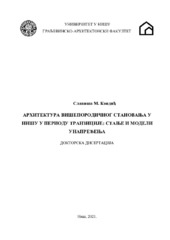Prikaz osnovnih podataka o disertaciji
Arhitektura višeporodičnog stanovanja u Nišu u periodu tranzicije: stanje i modeli unapređenja
| dc.contributor.advisor | Jovanović, Goran | |
| dc.contributor.other | Mitković, Petar | |
| dc.contributor.other | Lojanica, Vladimir | |
| dc.creator | Kondić, Slaviša | |
| dc.date.accessioned | 2022-11-13T14:39:04Z | |
| dc.date.available | 2022-11-13T14:39:04Z | |
| dc.date.issued | 2021-10-18 | |
| dc.identifier.uri | http://eteze.ni.ac.rs/application/showtheses?thesesId=8509 | |
| dc.identifier.uri | https://fedorani.ni.ac.rs/fedora/get/o:1777/bdef:Content/download | |
| dc.identifier.uri | https://plus.cobiss.net/cobiss/sr/sr/bib/55274505 | |
| dc.identifier.uri | https://nardus.mpn.gov.rs/handle/123456789/20876 | |
| dc.description.abstract | Multi-family housing in the Republic of Serbia in the period of transition from the socialist to the capitalist social system and from the planned to the market based economy, is characterized by a drastic decline in quality compared to the previous period. In order to improve the current state, a scientificmethodological approach of the evaluation of the condition and quality of the current residential architecture was applied. Based on that, the dominant impact factors that generated such a condition were identified. This research conducts a process of analysis of urban regulations and their impact on housing quality, comparative analysis and valorization of modern, and architectural solutions from previous periods, domestic and foreign regulations in this area, as well as research of the needs and attitudes of tenants through a survey. In that way, the parameters that significantly influenced the achieved quality of housing were identified. Based on the results of the research and through critical analysis of current trends, models for qualitative improvement of residential architecture have been formed. These models include regulatory correction recommendations, urban design models, and architectural design models and recommendations. The ultimate goal of the research is to improve the regulations and general situation in multi-family housing architecture in Nis and Serbia, and potentially in other countries with significant negative impact of the transition process on the quality of multi-family housing. | en |
| dc.format | application/pdf | |
| dc.language | sr | |
| dc.publisher | Универзитет у Нишу, Грађевинско-архитектонски факултет | sr |
| dc.rights | openAccess | en |
| dc.rights.uri | https://creativecommons.org/licenses/by/4.0/ | |
| dc.source | Универзитет у Нишу | sr |
| dc.subject | višeporodično stanovanje | sr |
| dc.subject | Multi-family housing | en |
| dc.subject | improvement models | en |
| dc.subject | architectural design | en |
| dc.subject | urban planning | en |
| dc.subject | modeli unapređenja | sr |
| dc.subject | arhitektonsko projektovanje | sr |
| dc.subject | urbanističko planiranje 7 | sr |
| dc.title | Arhitektura višeporodičnog stanovanja u Nišu u periodu tranzicije: stanje i modeli unapređenja | sr |
| dc.type | doctoralThesis | |
| dc.rights.license | BY | |
| dc.identifier.fulltext | http://nardus.mpn.gov.rs/bitstream/id/147213/Kondic_Slavisa_M.pdf | |
| dc.identifier.fulltext | http://nardus.mpn.gov.rs/bitstream/id/147212/Doctoral_thesis_12825.pdf | |
| dc.identifier.rcub | https://hdl.handle.net/21.15107/rcub_nardus_20876 |



